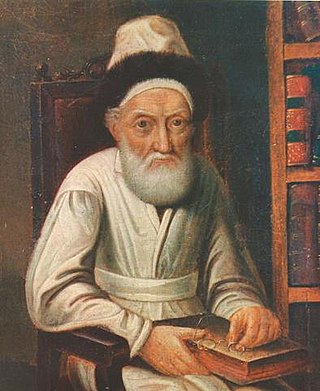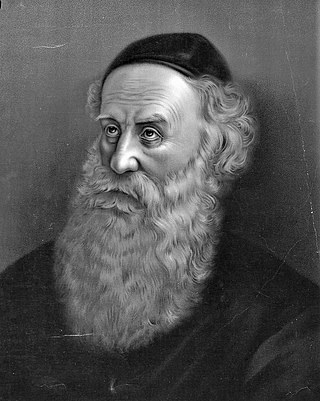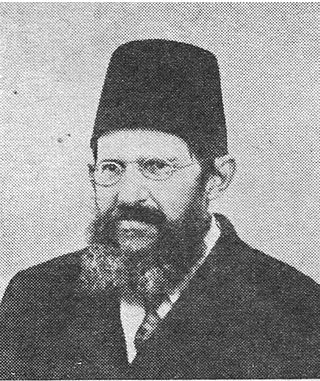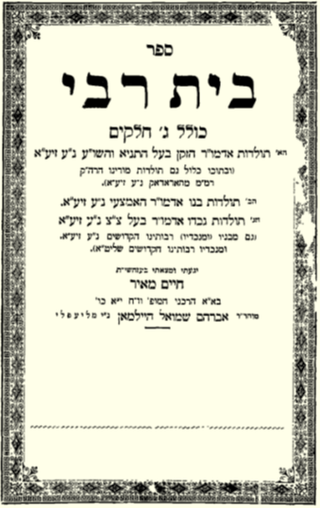
Chabad, also known as Lubavitch, Habad and Chabad-Lubavitch, is a dynasty in Hasidic Judaism. Belonging to the Haredi (ultra-Orthodox) branch of Orthodox Judaism, it is one of the world's best-known Hasidic movements, as well as one of the largest Jewish religious organizations. Unlike most Haredi groups, which are self-segregating, Chabad mainly operates in the wider world and caters to nonobservant Jews.

Menachem Mendel Schneersohn also known as the Tzemach Tzedek was an Orthodox rabbi, leading 19th-century posek, and the third rebbe of the Chabad Lubavitch Hasidic movement.

Shneur Zalman of Liadi, commonly known as the Alter Rebbe or Baal Hatanya, was a rabbi and the founder and first Rebbe of Chabad, a branch of Hasidic Judaism. He wrote many works and is best known for Shulchan Aruch HaRav, Tanya, and his Siddur Torah Or, compiled according to the Nusach Ari.

The Shulchan Aruch HaRav is especially a record of prevailing halakha by Rabbi Shneur Zalman of Liadi (1745–1812), known during his lifetime as HaRav and as the first Rebbe of Chabad. Within the Chabad community the work is known as the Alter Rebbe's Shulchan Aruch.

The Tanya is an early work of Hasidic philosophy, by Rabbi Shneur Zalman of Liadi, the founder of Chabad Hasidism, first published in 1796. Its formal title is Likkutei Amarim but is more commonly known by its first word (tanya), which in Aramaic means "it has been taught". Zalman is referring to a baraita in "Niddah" chapter 3 in the word’s first usage. The Tanya is composed of five sections that define Hasidic mystical psychology and theology as a handbook for daily spiritual life in Jewish observance.

Isaiah or Yeshayahu ben Avraham Ha-Levi Horowitz, , also known as the Shelah HaKaddosh after the title of his best-known work, was a prominent rabbi and mystic.

Toldos Aharon is a devout, insular, fervently anti-Zionist Hasidic group. The group is characterized by extreme conservatism and a desire to preserve the life of the old Yishuv in Jerusalem, in sharp opposition to Zionism, in a strict Haredi way of life, in a special style of clothing, and in an emphasis on prayer at a moderate pace and with enthusiasm. Headquartered in Jerusalem's Mea Shearim neighborhood, it also has significant numbers in Ramat Beit Shemesh, and New York City, and additional members in Tiberias and in Harish. The sect has about 1,800 households. Toldos Aharon is a split-off from Shomer Emunim. It is led by its Rebbe, Dovid Kohn.

Strashelye was a branch of the Chabad school of Hasidic Judaism, named after the town Strashelye (Starasel'lye) in the Mohilev Province of present-day Belarus, where its leader lived. Like all Hasidism it is based on the teachings and customs of Chasidut as taught by the Baal Shem Tov, in turn based on the Kabbalistic works of Rabbi Isaac Luria.
Hasidic philosophy or Hasidism, alternatively transliterated as Hasidut or Chassidus, consists of the teachings of the Hasidic movement, which are the teachings of the Hasidic rebbes, often in the form of commentary on the Torah and Kabbalah. Hasidism deals with a range of spiritual concepts such as God, the soul, and the Torah, dealing with esoteric matters but often making them understandable, applicable and finding practical expressions.

Israel Dov Frumkin was an author and pioneer of Hebrew journalism.

Hillel HaLevi Malisov of Paritch, a levite by birth, commonly known as Reb Hillel Paritcher (1795-1864) was a famous Orthodox Jewish Chabad Rabbi born in Khmilnyk, Ukraine. Specifically, he served as a Mashpia and communal rabbi in the towns of Paritch, near Minsk, Russia, and Bobroisk, Belarus. He was considered exceptional in his scholarship and piety, and is referred to as a Tzadik, and even as a "half Rebbe."

Sifrei Kodesh, commonly referred to as sefarim, or in its singular form, sefer, are books of Jewish religious literature and are viewed by religious Jews as sacred. These are generally works of Torah literature, i.e. Tanakh and all works that expound on it, including the Mishnah, Midrash, Talmud, and all works of Musar, Hasidism, Kabbalah, or machshavah. Historically, sifrei kodesh were generally written in Hebrew with some in Judeo-Aramaic or Arabic, although in recent years, thousands of titles in other languages, most notably English, were published. An alternative spelling for 'sefarim' is seforim.
Zalman (זלמן) is a Yiddish-language variant of Solomon. The name was common among European Jews, and it still has usage in many Haredi and especially Hasidic communities all over the world. Some of the founders of modern Israel bore this name, including Zalman Shazar, the third Israeli president. Nowadays this is not a common name in the modern secular Israeli circles, being identified as a diaspora name.
Haim Raphael HaLevi ben Aaron of Staroselye was the second and last rebbe of the Strashelye movement, an extinct branch of the Chabad school of Hasidic Judaism. The branch is named Strashelye after the town in the Mohilev Province of present-day Belarus where its leader lived. Like all Hasidim it is based on the teachings and customs of Chasidut as taught by the Baal Shem Tov, in turn based on the Kabbalistic works of Rabbi Isaac Luria. Rabbi Haim's father was Aaron HaLevi ben Moses of Staroselye, a disciple of Rabbi Shneur Zalman of Liadi and a friend of Rabbi Dovber Schneuri.

Chabad offshoot groups are those spawned from the Chabad Hasidic Jewish movement. Many of these groups were founded to succeed previous Chabad leaders, acting as rivals to some of the dynastic rebbes of Chabad. Others were founded by former students of the movement, who, in forming their own groups, drew upon their experiences at Chabad.

Chabad philosophy comprises the teachings of the leaders of Chabad-Lubavitch, a Hasidic movement. Chabad Hasidic philosophy focuses on religious concepts such as God, the soul, and the meaning of the Jewish commandments.

Anger in Judaism is treated as a negative trait to be avoided whenever possible. The subject of anger is treated in a range of Jewish sources, from the Hebrew Bible and Talmud to the rabbinical law, Kabbalah, Hasidism, and contemporary Jewish sources.

Hasidic Judaism in Lithuania is the history of Hasidic Judaism and Hasidic philosophy in Lithuania and parts of modern-day Belarus. Hasidic Judaism in Lithuania began with R. Aaron Perlow of Karlin (Karalin) (1736–1772), R. Menachem Mendel of Vitebsk (1730?–1788) R. Shneur Zalman of Liadi (Lyady) (1745–1812) and to a lesser extent R. Hayim Haykl of Amdur (Indura), all of whom were disciples of R. Dov Ber of Mezeritch (Mezhirichi), who in part was the successor to the R. Israel Baal Shem Tov who founded Hasidic Judaism in Western Ukraine. In its earliest years, Lithuanian Hasidism suffered immense persecution by the Lithuanian Misnagdic rabbinate, who attempted to ban and excommunicate Hasidism on several occasions in Lithuania beginning with R. Elijah b. Solomon Zalman of Vilna (1720–1797), who was the earliest disseminator of anti-Hasidic thought which flourished in Lithuania.

Beit Rebbe is a book of Chabad Hasidic history written by Hayim Meir Heilman, published in Berditchev in 1902. The work is seen as among the first to establish a Hasidic tradition of historiography.













